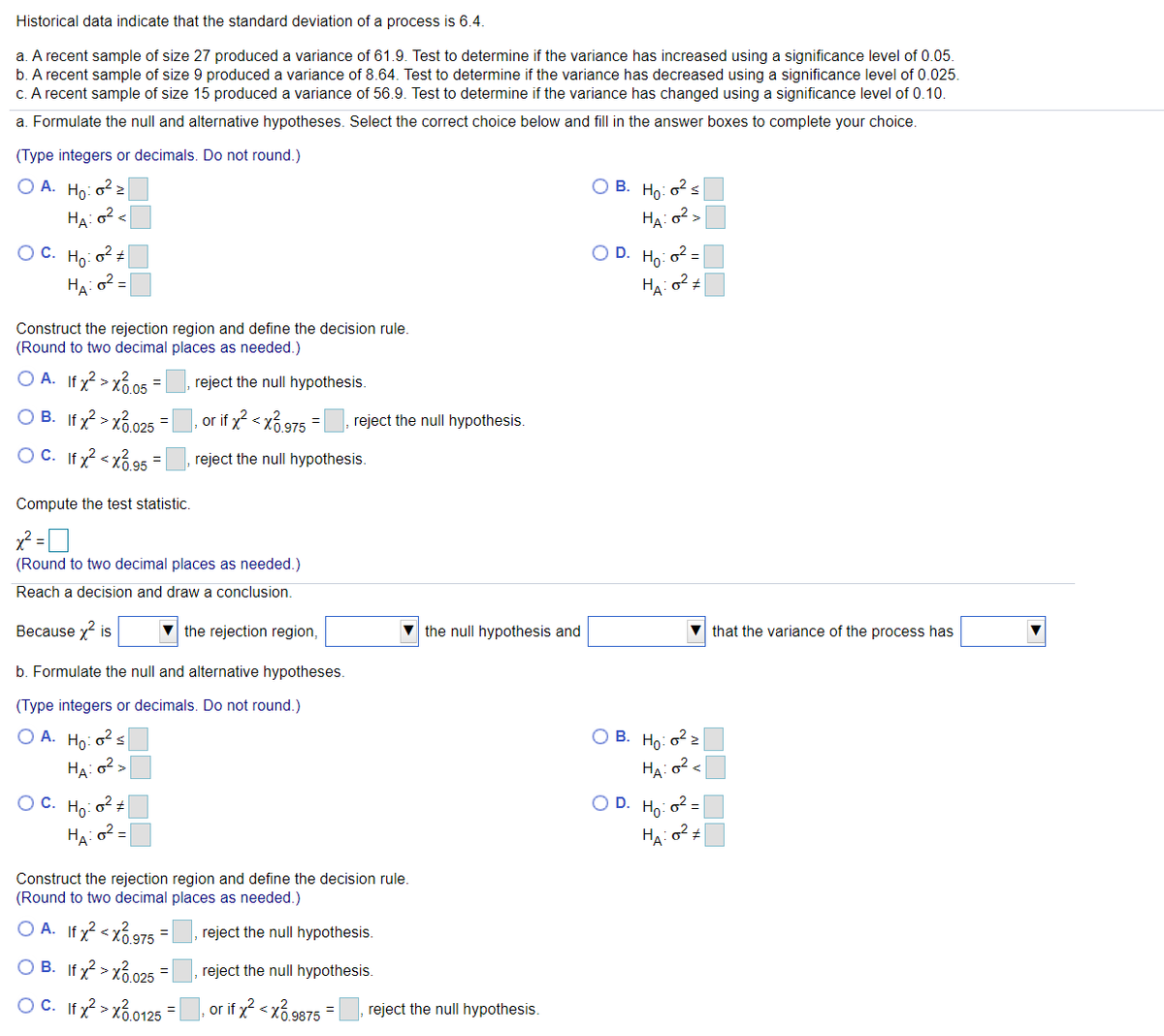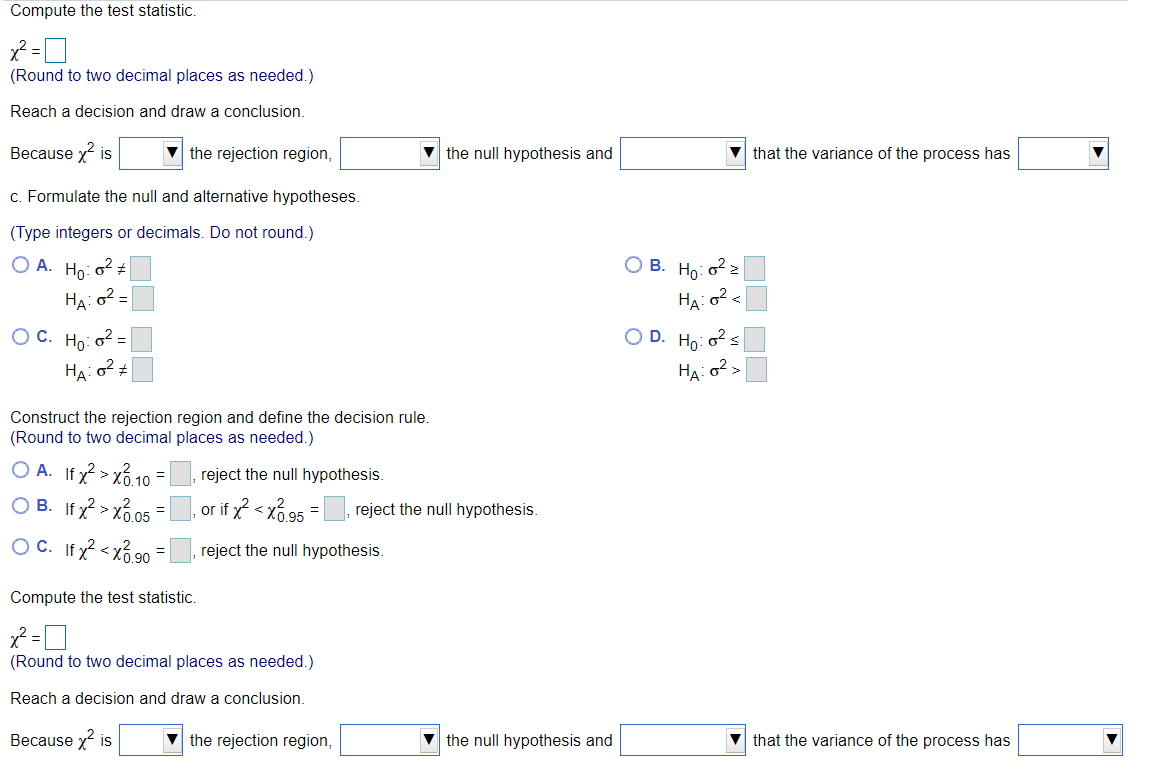Historical data indicate that the standard deviation of a process is 6.4. a. A recent sample of size 27 produced a variance of 61.9. Test to determine if the variance has increased using a significance level of 0.05. b. A recent sample of size 9 produced a variance of 8.64. Test to determine if the variance has decreased using a significance level of 0.025. c. A recent sample of size 15 produced a variance of 56.9. Test to determine if the variance has changed using a significance level of 0.10. a. Formulate the null and alternative hypotheses. Select the correct choice below and fill in the answer boxes to complete your choice. (Type integers or decimals. Do not round.) O A. Ho: o2 2 ОВ. Họ: OC. Ho: o? O D. Ho: o2 = HA: o² = Construct the rejection region and define the decision rule. (Round to two decimal places as needed.) O A. Ifx? > xổos = O B. If? > xổ.025 OC. If? HA o? < Oc. O D. Ho o2 = Но HA: o2 = HA: o2 Construct the rejection region and define the decision rule. (Round to two decimal places as needed.) O A. If x < xố.975 reject the null hypothesis. O B. Ifx > xổ.025 reject the null hypothesis. O C. Ifx? > xảo125 =, or if x? < x3 9876 reject the null hypothesis.
Historical data indicate that the standard deviation of a process is 6.4. a. A recent sample of size 27 produced a variance of 61.9. Test to determine if the variance has increased using a significance level of 0.05. b. A recent sample of size 9 produced a variance of 8.64. Test to determine if the variance has decreased using a significance level of 0.025. c. A recent sample of size 15 produced a variance of 56.9. Test to determine if the variance has changed using a significance level of 0.10. a. Formulate the null and alternative hypotheses. Select the correct choice below and fill in the answer boxes to complete your choice. (Type integers or decimals. Do not round.) O A. Ho: o2 2 ОВ. Họ: OC. Ho: o? O D. Ho: o2 = HA: o² = Construct the rejection region and define the decision rule. (Round to two decimal places as needed.) O A. Ifx? > xổos = O B. If? > xổ.025 OC. If? HA o? < Oc. O D. Ho o2 = Но HA: o2 = HA: o2 Construct the rejection region and define the decision rule. (Round to two decimal places as needed.) O A. If x < xố.975 reject the null hypothesis. O B. Ifx > xổ.025 reject the null hypothesis. O C. Ifx? > xảo125 =, or if x? < x3 9876 reject the null hypothesis.
MATLAB: An Introduction with Applications
6th Edition
ISBN:9781119256830
Author:Amos Gilat
Publisher:Amos Gilat
Chapter1: Starting With Matlab
Section: Chapter Questions
Problem 1P
Related questions
Concept explainers
Power Operation
Power operation is topic of algebra in Math. It is use to represent repeated multiplication. Very big number and very small number can be easily express using power operation. Power operation is useful in many fields. In space engineering, it helps in representing the distance or size of particular heavenly body. In medical field, it is used to represent very small size. In medical field it helps to mention size of bacteria or virus.
Exponents
The exponent or power or index of a variable/number is the number of times that variable/number is multiplied by itself.
Question
Please make sure to do the rounding when it's needed.

Transcribed Image Text:Historical data indicate that the standard deviation of a process is 6.4.
a. A recent sample of size 27 produced a variance of 61.9. Test to determine if the variance has increased using a significance level of 0.05.
b. A recent sample of size 9 produced a variance of 8.64. Test to determine if the variance has decreased using a significance level of 0.025.
C. A recent sample of size 15 produced a variance of 56.9. Test to determine if the variance has changed using a significance level of 0.10.
a. Formulate the null and alternative hypotheses. Select the correct choice below and fill in the answer boxes to complete your choice.
(Type integers or decimals. Do not round.)
O A. Ho: o2 2
ОВ. Но-
HA: o2<
HA: 02>
OC.
Но
O D. Ho: o2 =
HA: o2 =
HA
Construct the rejection region and define the decision rule.
(Round to two decimal places as needed.)
O A. Ifx? > xổ.05
O B. Ifx > xổ.025
O C. Ifx < xổ 95
reject the null hypothesis.
or if x < x6 975 =|
reject the null hypothesis.
reject the null hypothesis.
Compute the test statistic.
(Round to two decimal places as needed.)
Reach a decision and draw a conclusion.
Because x is
the rejection region,
v the null hypothesis and
that the variance of the process has
b. Formulate the null and alternative hypotheses.
(Type integers or decimals. Do not round.)
O A. Ho: o2s
ОВ. Но-
HA: o2>
HA: o2 <
Oc.
Но
O D. Ho: o2 =
Ha: o2
HA: o² ±
Construct the rejection region and define the decision rule.
(Round to two decimal places as needed.)
O A. If x? < xổ 975 =
O B. If y > xo.025
reject the null hypothesis.
reject the null hypothesis.
OC. If x? > xổ.0125
or if x? < xổ 9875
reject the null hypothesis.

Transcribed Image Text:Compute the test statistic.
(Round to two decimal places as needed.)
Reach a decision and draw a conclusion.
Because x is
v the rejection region,
v the null hypothesis and
V that the variance of the process has
c. Formulate the null and alternative hypotheses.
(Type integers or decimals. Do not round.)
O A. Ho: o? +
O B. Ho: o? 2
HA: o2 =
O C. Ho: o2 =
O D. Ho: o s
HA:
HA: 02
Construct the rejection region and define the decision rule.
(Round to two decimal places as needed.)
O A. If x? > xổ 10
O B. If x? > xổ.05
OC. If? < xổ 90
reject the null hypothesis.
, or if x2 <
reject the null hypothesis.
reject the null hypothesis.
Compute the test statistic.
(Round to two decimal places as needed.)
Reach a decision and draw a conclusion.
Because x is
v the rejection region,
V the null hypothesis and
that the variance of the process has
Expert Solution
This question has been solved!
Explore an expertly crafted, step-by-step solution for a thorough understanding of key concepts.
This is a popular solution!
Trending now
This is a popular solution!
Step by step
Solved in 2 steps with 7 images

Knowledge Booster
Learn more about
Need a deep-dive on the concept behind this application? Look no further. Learn more about this topic, statistics and related others by exploring similar questions and additional content below.Recommended textbooks for you

MATLAB: An Introduction with Applications
Statistics
ISBN:
9781119256830
Author:
Amos Gilat
Publisher:
John Wiley & Sons Inc

Probability and Statistics for Engineering and th…
Statistics
ISBN:
9781305251809
Author:
Jay L. Devore
Publisher:
Cengage Learning

Statistics for The Behavioral Sciences (MindTap C…
Statistics
ISBN:
9781305504912
Author:
Frederick J Gravetter, Larry B. Wallnau
Publisher:
Cengage Learning

MATLAB: An Introduction with Applications
Statistics
ISBN:
9781119256830
Author:
Amos Gilat
Publisher:
John Wiley & Sons Inc

Probability and Statistics for Engineering and th…
Statistics
ISBN:
9781305251809
Author:
Jay L. Devore
Publisher:
Cengage Learning

Statistics for The Behavioral Sciences (MindTap C…
Statistics
ISBN:
9781305504912
Author:
Frederick J Gravetter, Larry B. Wallnau
Publisher:
Cengage Learning

Elementary Statistics: Picturing the World (7th E…
Statistics
ISBN:
9780134683416
Author:
Ron Larson, Betsy Farber
Publisher:
PEARSON

The Basic Practice of Statistics
Statistics
ISBN:
9781319042578
Author:
David S. Moore, William I. Notz, Michael A. Fligner
Publisher:
W. H. Freeman

Introduction to the Practice of Statistics
Statistics
ISBN:
9781319013387
Author:
David S. Moore, George P. McCabe, Bruce A. Craig
Publisher:
W. H. Freeman